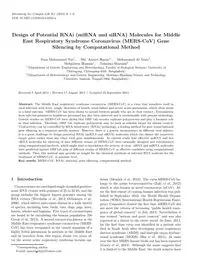
2014 Design of potential RNAi (miRNA and siRNA) molecules for Middle East respiratory syndrome coronavirus (MERS-CoV) ge PDF
Preview 2014 Design of potential RNAi (miRNA and siRNA) molecules for Middle East respiratory syndrome coronavirus (MERS-CoV) ge
Interdiscip Sci Comput Life Sci (2014) 6: 1–9 DOI: 10.1007/s12539-014-0233-x Design of Potential RNAi (miRNA and siRNA) Molecules for Middle East Respiratory Syndrome Coronavirus (MERS-CoV) Gene Silencing by Computational Method Suza Mohammad Nur1, Md. Anayet Hasan1∗, Mohammad Al Amin1, Mehjabeen Hossain1, Tahmina Sharmin2 1(Department of Genetic Engineering and Biotechnology, Faculty of Biological Sciences, University of Chittagong, Chittagong-4331, Bangladesh) 2(Department of Biotechnology and Genetic Engineering, Mawlana Bhashani Science and Technology University, Santosh, Tangail-1902, Bangladesh) Received 8 April 2014 / Revised 17 August 2014 / Accepted 22 September 2014 Abstract: The Middle East respiratory syndrome coronavirus (MERS-CoV) is a virus that manifests itself in viral infection with fever, cough, shortness of breath, renal failure and severe acute pneumonia, which often result in a fatal outcome. MERS-CoV has been shown to spread between people who are in close contact. Transmission from infected patients to healthcare personnel has also been observed and is irredeemable with present technology. Genetic studies on MERS-CoV have shown that ORF 1ab encodes replicase polyproteins and play a foremost role in viral infection. Therefore, ORF 1ab replicase polyprotein may be used as suitable target for disease control. Viral activity can be controlled by RNA interference (RNAi) technology, a leading method for post transcriptional gene silencing in a sequence specific manner. However, there is a genetic inconsistency in different viral isolates; it is a great challenge to design potential RNAi (miRNA and siRNA) molecules which can silence the respective target genes rather than any other viral gene simultaneously. In current study four effective miRNA and five siRNA molecules for silencing of nine different strains of MERS-CoV were rationally designed and corroborated using computational methods, which might lead to knockdown the activity of virus. siRNA and miRNA molecules were predicted against ORF1ab gene of different strains of MERS-CoV as effective candidate using computational methods. Thus, this method may provide an insight for the chemical synthesis of antiviral RNA molecule for the treatment of MERS-CoV, at genomic level. Key words: MERS-CoV, RNAi, antiviral, gene silencing, computational method. 1 Introduction Coronaviruses are enveloped single-stranded positive- sense RNA viruses with genomes of 25 to 32 kb, and the group includes the biggest known genomes among the RNA viruses (Wertheim et al., 2013; Orbalenya et al., 2006), which infects and causes disease in a wide variety of species, including bats, birds, cats, dogs, pigs, mice, horses, whales and humans. Five types of coronaviruses are found to be circulating the human population (De Groot et al., 2013). A second coronavirus known as the Middle East respiratory syndrome coronavirus (MERS- CoV) has been recognized as the causal organism of a highly lethal pneumonia in patients in the Middle East and in travelers from this region about ten years af- ter the severe acute respiratory syndrome became epi- ∗Corresponding author. E-mail: anayet
